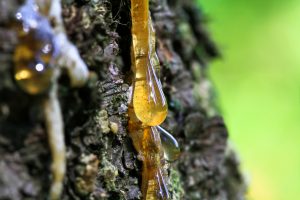
Researchers develop pine sap-based thermally stable plastic
Canadian Plastics
Environment Materials Research & Development SustainabilityA Florida State University research team’s discovery of a new plastic derived from pine sap has the potential to be a gamechanger for new sustainable materials.

Photo Credit: Adobe Stock/yanikap
Given our monopoly on producing syrup, this development sounds like it should be Canadian, but it isn’t: a research team has discovered a new plastic derived from pine sap.
The credit for this innovation actually goes to researchers at Florida State University (FSU), and they’re describing it as a significant step in the right direction for new plastics and a gateway discovery that could lead to several new materials.
“Ninety-nine percent of plastics today are produced from finite fossil fuels with increasing demand and limited geographic availability,” said FSU associate professor of chemistry and biochemistry Justin Kennemur, the principal investigator on the study. “Producing materials from renewable resources, and particularly pine sap, which may be harvested without killing the tree, is a noteworthy effort.”
Alpha-pinene, the most abundant molecule produced from pine sap, is notoriously difficult to turn into plastics so it currently has limited uses. It’s primarily found in turpentine-based cleaners and solvents. Mark Yarolimek, an FSU doctoral student in polymer chemistry who led the study, first synthetically modified the alpha-pinene to make the compound known as delta-pinene.
“I put alpha-pinene through a series of chemical reactions, multiple purifications, and some trial and error, which eventually proved successful in converting it to delta-pinene,” he said. “Once we obtained purified liquid delta-pinene, I converted that into the resultant plastic, poly-delta-pinene, through one final chemical reaction.”
Yarolimek and Heather Bookbinder, who served as an undergraduate researcher on the project before graduating with a bachelor’s in exercise physiology in 2020, then performed a range of “polymerizations” – chemical reactions to transform small liquid molecules into solid macromolecules – to test how effective this molecule was at becoming a plastic. These tests included measuring how much delta-pinene was converted to plastic in a single reaction, how well the researchers could control molecule growth, and how condition variability affected the materials. They also characterized the various material properties of the plastic, such as what temperature at which the polymer melts and how much heat it can withstand before it decomposes, as well as exploring the materials’ molecular structure.
Brianna Coia, a graduate researcher in the Kennemur Group, simultaneously analyzed the delta-pinene to understand if it possessed the proper thermodynamic properties to undergo polymerization. With resources from the FSU Research Computing Center, Coia performed density functional theory calculations, and her computational results paralleled well with Yarolimek and Bookbinder’s experimental findings.
The team has already worked with the FSU Office of Commercialization to file a patent for the material they discovered.
Making new bio-based plastics is only part of the development process; the rest involves the ultimate fate of the plastic, Kennemur said. For this high-performance material, having a short shelf life from being biodegradable would be undesirable, but it still needs a way to be recycled. That may mean developing decomposition processes via a chemical stimulus.
“Our research is invested in both. We make new materials, but we are also investigating their chemical recyclability,” Kennemur said. “We made this new plastic, but this is just the beginning. We need to also learn how to unmake the plastic and we have plans to start investigating that.”
